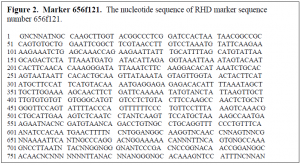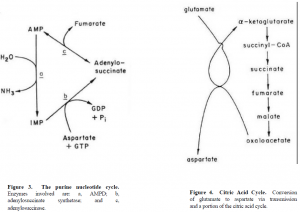Ryan D. McAllister and Dr. David Kooyman, Animal Science
Round heart disease (RHD) is a spontaneous occurring cardiomyopathy in turkeys. The domestic turkey Meleagris gallopavo is affected by low body weight and premature death due to congestive heart failure from RHD (1). RHD results in decreased profitability for the animal agriculturists and higher prices for turkey products. DNA markers have been identified for both normal turkeys and for turkeys affected by RHD. These genetic markers have been amplified using Random Amplified Polymorphic DNA (RAPD) analysis (2). 16 DNA marker sequences amplified by RAPD have now been determined (3). Basic Local Alignment Search Tool (BLAST) is a computer program designed to search homology of the query DNA in the available DNA and protein sequence databases (4). Here we describe how BLAST was utilized to find homologous DNA and putative protein sequences of the RHD nucleotide marker sequences. Furthermore, we propose possible mechanisms of RHD.
Introduction
Tissue samples were obtained from 10-14 day old poults that exhibited lesions consistent with RHD on gross necropsy. Tissue from clinically normal birds, as demonstrated by ECG recordings, were also collected (Moroni Feed Co., Moroni, Utah). The DNA was purified from these samples and used to identify 16 DNA marker sequences that correlated with either normal or RHD positive birds (3). The 6 sequenced DNA markers that associated with RHD positive birds were subjected to BLAST analysis in the present study.
Methods & Results
The Internet available protein and nucleotide alignment computer program BLAST (http://www.ncbi.nlm.nih.gov/BLAST) was utilized to discover DNA sequences homologous to the RHD nucleotide marker sequences. Curiously, assorted open and unidentified reading frames from viruses, chicken, and bacteria were identified with homology to the marker sequences. From numerous gene portions found to be homologous to the RHD markers, we detected a gene coding for the heart isoform of the enzyme Adenosine Monophosphate Deaminase (AMPD). The Ampd3 gene, which codes for the heart-type isoform of AMPD in mice (5), was found to be 93% homologous to the turkey genetic marker number 656f121 over a 66-nucleotide region (figs. 1 and 2).
Discussion
AMPD is a soluble enzyme in eukaryotes, which catalyzes AMP hydrolysis to inosine monophosphate and ammonia. Furthermore, AMPD plays an important role in purine metabolism (Fig. 3) (6). This may be one mechanism to maintain cellular ATP concentration. In addition, AMPD is believed to have an important role in energy-requiring cells, like skeletal and heart muscle cells. Since AMPD activity in muscle cells is 50-100 times higher than in nonmuscle cells, it is likely that a mutant form of AMPD causes cellular respiration to cease. In humans, metabolic myopathy associated with AMPD deficiency has been reported (7). Furthermore, the clinical manifestations of AMPD deficiency as reported in humans corresponds to the clinical signs that we have noted from RHD in turkeys.
Normal muscle activity up-regulates AMPD activity and increases flux through the purine nucleotide cycle. This leads to an increase in energy production through the generation of intermediates for the citric acid cycle (Fig. 4) (6) from amino acids and through stimulation of glycolysis (7). Thus, it is anticipated that an AMPD deficiency may disrupt the purine nucleotide cycle and might lead to heart muscle dysfunction.
Conclusion
A defective gene coding for heart type AMPD could result in congestive heart failure in RHD turkeys. Further analysis of AMPD may determine that the homologous regions are active sites for AMPD. Furthermore, performing an assay for ammonia concentrations in the affected heart cells may give more details about the function of AMPD in diseased turkeys.
Certainly, the eventual goal of this research will be to eliminate the disease from infected turkeys before it is transferred to the population. By knowing that the DNA sequences are related to a genetic disorder, it may be possible to eliminate RHD from an affected population through selective breeding.
References



